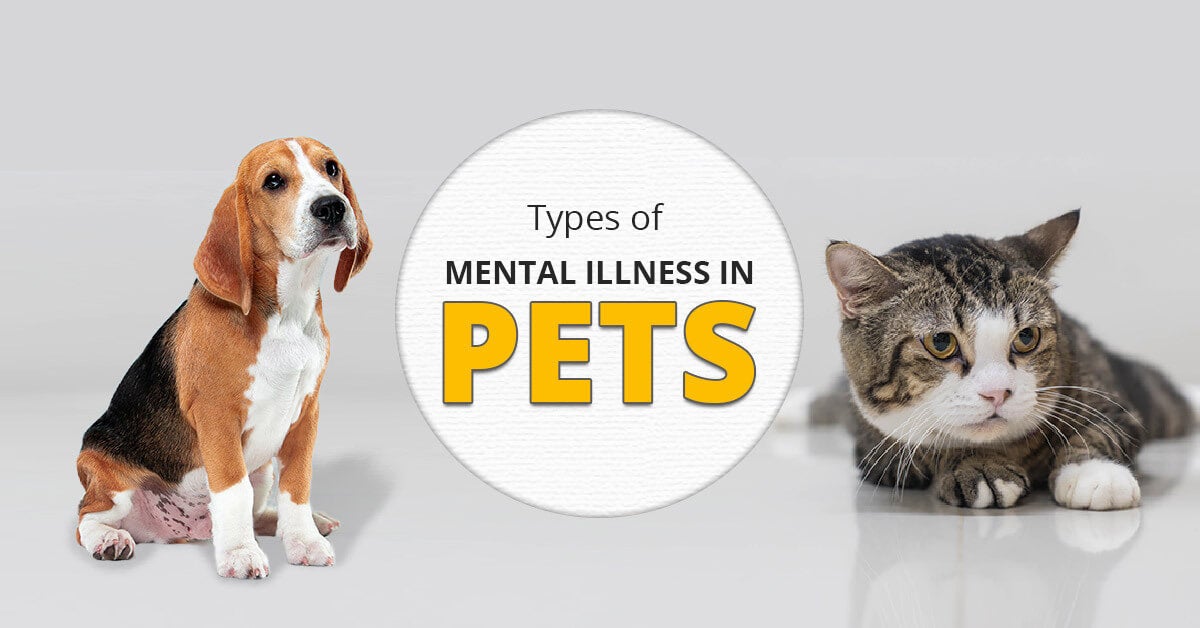Mental illness and mental health care were some of the hot words tossed around, especially during the pandemic lockdown.
However, psychological disorders are not a pandemic term but an endemic of their own. In fact, as per psychiatry.org, nearly one in five U.S adults have some form of mental illness.
Turns out, psychological disorder is not only a human thing! Mental illness in pets is slowly becoming a rising concern for many veterinarians.
While humans demonstrate mental issues most often due to chemical reactions in their brains, pets do the same when they are unable to receive what they seek or have been mistreated.
Here are a few things you can know and understand about mental illness in pets.
Mental Illness in Pets
As per a study conducted by the Department of Dairy and Animal Science at Pennsylvania State University for Psychology Today, pets with traumatic past, anxiety, and depression do not live as long as their healthier peers.
Stress is often the reason behind their shorter life spans as it affects their cardiovascular health, physical capability, and skin disorders, to name a few.
Following are the common conditions that pets often suffer from.
1. Separation Anxiety
This is most usual for dogs and cats, who often end up being anxious if they cannot locate their pet parents.
When left alone, these pets feel deserted and experience trauma of abandonment that interferes with their socialization skills.
This behavior is demonstrated by them barking/meowing incessantly, scratching the door, whining, escaping physical boundaries, and destroying objects until their owners return.
2. Depression
Often displayed by K9 officers and pets who have been through amputation or are suffering from a chronic illness. They give cues about their depressed state of mind by withdrawing themselves, losing interest in things once they fancied, and turning away food.
3. Dementia
Like in the human geriatric population, dementia is a usual illness affecting senior pets. They often exhibit memory loss and disorientation by getting lost around the house or forgetting where they kept their favorite toys.
4. Noise Anxiety
Animals are extremely sensitive to sound, and loud noise can easily lead them to a frenzy. High decibels affect the sensitive nerves in their ears and can lead to anxiety. Some of the examples of troubling noises are sirens, loud music, fireworks, and thunderstorms.
5. Obsessive-Compulsive Disorder
Like humans, animals like cats and dogs can also suffer from obsessive-compulsive disorders. These are mostly recognizable by activities like incessant grooming in cats and uncontrolled digging and chasing their tails by dogs.
Common Examples of Mental issues in Pets
Dogs, cats, horses, and other domesticated animals have their own behavior patterns that indicate a psychological disorder.
Some of the most common examples are as follows:
1. House Cats Display OCD Behavior
You see your cat obsessively cleaning itself, and you might joke about him/her suffering from OCD. Jokes aside, this observation is pretty accurate, and researchers believe that excessive mewing, grooming, and pacing can be signs of pain, boredom, and anxiousness.
They also indicate that such actions secrete pain-relieving chemicals in the cats’ brains that might help ease their anxiety for a while.
In such cases, cat owners need to ensure that their cat receives ample attention and simulation, and in case things don’t work, it is time to visit the vet.
2. K9 Dogs Exhibit PTSD Symptoms
The K9 members, just like human soldiers, often revisit the traumatic experience and, as a result, often exhibit symptoms that resemble post-traumatic stress disorder.
The battle memories of the war often plague many K9 officers, who return from high conflict areas. Earlier, dogs with PTSD would be euthanized upon arrival. However, more and more veterinarians are coming up with counseling measures to help these doggos through tough times.
3. Horses with Little No Activity Display Odd Behaviors
Not many can think of a domestic animal more active than a horse. With the capability to gallop for miles and work for hours, horses are naturally wired to lead an active lifestyle.
However, if they are not stimulated, they often turn to destructive behavior in order to wade away their boredom.
Some of these activities can be kicking the walls, ‘cribbing’/chewing on wood, and pacing around frantically.
In order to keep their mental peace, horses should be given plenty of exercises and someone to provide them with company as well. Ideally, they should socialize with other horses, but many tend to have a soft corner towards other farm animals like goats and hens as well.
4. Insomnia and Sleep Deprivation
Worried animals often tend to lose sleep. This is especially common during fireworks or thunderstorms that often scare animals with their loud noises.
These occasions can cause distress, anxiety, and pain to animals, both at home and in the wild.
Their sleep deprivation and anxiety are often evident by them whimpering in a corner or bundled up in closed spaces to avoid any interaction with whatever scares them.
How Can Owners Helps Pets with Mental Illnesses
It is wrong to believe that pets with mental illnesses cannot be cured. Like humans, pets too have the unbound capability to bounce back from adversities, but with the right support and lots of patience.
Tweaks in everyday life and constant encouragement can help them be more comfortable in their surroundings and have happier lives.
If you believe that your pet might be undergoing any mental trauma, it is always advisable to talk to a veterinarian who can help you with the diagnosis and the remedy.
The diagnosis may include understanding your pet’s behavior, past history, physical injuries, if any, to name a few that will help create a treatment plan for your pet. Most experts include the following in their treatment plan:
- Mental simulation
- Make their surroundings more compatible with them. This may include physical tweaks like the temperature
- Physical simulation in the form of planned workouts
- Supplements and medication.










